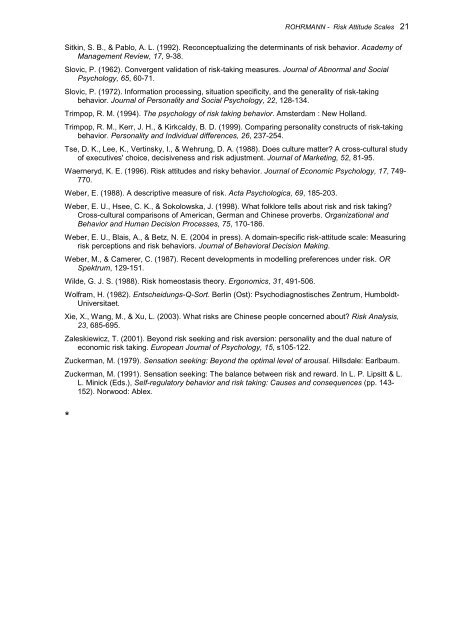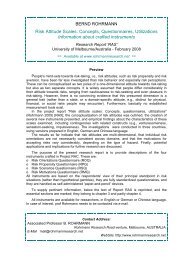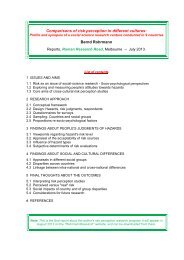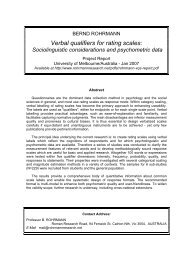ROHRMANN - <strong>Risk</strong> <strong>Attitude</strong> <strong>Scales</strong> 20 Kogan, N., & Wallach, M. A. (1964). <strong>Risk</strong> taking: A study in cognition and personality. New York: Holt, Rinehart and Winston. Kogan, N., & Wallach, M. A. (1967). <strong>Risk</strong> taking as a funktion of the situation, the person and the group. New directions in Psychology, III, 111-278. Krueger, C., & Amelang, M. (1995). Bereitschaft zu riskantem Verhalten als Trait-Konstruct und Test- Konzept: Zur Entwicklung eines Fragebogens auf der Basis des Handlungs-Haeufigkeits- Ansatzes. Diagnostica, 41, 35-52. Lamm, H., Lamm-Trommsdorf, G. & Kogan, N. (1970): Pessimism-optimism and risk-taking in individual and group contexts. Journal of Personality and Social Psychology, 15, 366-374. Levenson, M. R. (1990). <strong>Risk</strong> taking and personality. Journal of Personality and Social Psychology, 58, 1073-1080. Lindemann, B. (Oct. 1997). <strong>Risk</strong> propensity scale. Personal communication via E-mail. Lopes, L. L. (1988). Between hope and fear: The psychology of risk. Advances in Experimental Social Psychology, 20, 255-295. Lopes, L., & Ogden, G. (1998). Modeling individual differences in risk attitude. Paper presented at the Contribution to Psychonomics, Dallas. Lupton, D. (1999). <strong>Risk</strong>. New York: Routledge. MacCrimmon, K. R., & Wehrung, D. A. (1986). Assessing risk propensity. In L. Daboni, A. Montesano, & M. Lines (Eds.), Recent developments in the foundations of utility and risk theory (pp. 291-309). Dordrecht: Reidel Press. McCrimmon, K. R., & Wehrung, D. A. (1986). Taking risks. New York: The Free Press. Nicholson, N., Soane, E., Fenton-O'Creevy, M., & Willman, P. (2005). Personality and domain-specific risk taking. Journal of <strong>Risk</strong> Research, 8, 157-176. Pennings, J. M. E., & Smidts, A. (2000). Assessing the construct validity of risk attitude. Management Science, 46, 1337-1348. Ralston, D. A., Gustafson, D. J., Elsass, P. M., Cheung, F., & Terpstra, R. H. (1992). Eastern values: A comparison of managers in the United States, Hong Kong, and the People's Republic of China. Journal of Applied Psychology, 77(5), 664-671. Rim, Y. (1964). Social attitudes and risk taking. Human relations, 17, 259-265. Rohrmann, B. (1991). The EQS Questionnaire on Decision Making (WOLFRAM 1982) - English version. Dept. of Psychology, Univ. of Melbourne. Rohrmann, B. (1994). <strong>Risk</strong> perception of different societal groups: Australian findings and crossnational comparisons; Australian Journal of Psychology, 46, 150-163. Rohrmann, B.: (1998). The risk notion - epistemological and empirical considerations; in: Stewart, M.G., & Melchers, R.E. (Eds.): Integrative risk assessment; Rotterdam: Balkema. Rohrmann, B. (1999). <strong>Risk</strong> perception research - Review and documentation; Research Center Juelich: RC Studies #68. Rohrmann, B. (2005). Perception of risk: Research, results, relevance. In Gough, J. (Ed.), Sharing the future. Christchurch: CAE publications. Schneider, K., & Rheinberg, F. (1996). Erlebnissuche und Risikomotivation. In M. Amelang (Ed.), Temperaments- und Persoenlichkeitsunterschiede (pp. 407-459). Goettingen: Hogrefe. Schubert, R., Brown, M., Gysler, M., Brachinger, H.W. (1999). Financial Decision Making: Are Women Really More <strong>Risk</strong> Averse? The American Economic Review, 89, 381-385. Schwenkmezger, P. (1977). Risikoverhalten und Risikobereitschaft. Weinheim: Beltz. Semler, G. (1994). Die Lust an der Angst - Warum sich Menschen freiwillig extremen Risikien aussetzen. Muenchen. Shure, G. H., & Meeker, R. J. (1967). A personality/attitude schedule for use in experimental bargaining studies. Journal of Psychology, 65, 233-252. Siegrist, M., Cvetkovich, G., Gutscher, H. (2002). <strong>Risk</strong> preference predictions and gender stereotypes. Organizational Behavior and Human Decision Processes, 87, 91-102.
ROHRMANN - <strong>Risk</strong> <strong>Attitude</strong> <strong>Scales</strong> 21 Sitkin, S. B., & Pablo, A. L. (1992). Reconceptualizing the determinants of risk behavior. Academy of Management Review, 17, 9-38. Slovic, P. (1962). Convergent validation of risk-taking measures. Journal of Abnormal and Social Psychology, 65, 60-71. Slovic, P. (1972). Information processing, situation specificity, and the generality of risk-taking behavior. Journal of Personality and Social Psychology, 22, 128-134. Trimpop, R. M. (1994). The psychology of risk taking behavior. Amsterdam : New Holland. Trimpop, R. M., Kerr, J. H., & Kirkcaldy, B. D. (1999). Comparing personality constructs of risk-taking behavior. Personality and Individual differences, 26, 237-254. Tse, D. K., Lee, K., Vertinsky, I., & Wehrung, D. A. (1988). Does culture matter? A cross-cultural study of executives' choice, decisiveness and risk adjustment. Journal of Marketing, 52, 81-95. Waerneryd, K. E. (1996). <strong>Risk</strong> attitudes and risky behavior. Journal of Economic Psychology, 17, 749- 770. Weber, E. (1988). A descriptive measure of risk. Acta Psychologica, 69, 185-203. Weber, E. U., Hsee, C. K., & Sokolowska, J. (1998). What folklore tells about risk and risk taking? Cross-cultural comparisons of American, German and Chinese proverbs. Organizational and Behavior and Human Decision Processes, 75, 170-186. Weber, E. U., Blais, A., & Betz, N. E. (2004 in press). A domain-specific risk-attitude scale: Measuring risk perceptions and risk behaviors. Journal of Behavioral Decision Making. Weber, M., & Camerer, C. (1987). Recent developments in modelling preferences under risk. OR Spektrum, 129-151. Wilde, G. J. S. (1988). <strong>Risk</strong> homeostasis theory. Ergonomics, 31, 491-506. Wolfram, H. (1982). Entscheidungs-Q-Sort. Berlin (Ost): Psychodiagnostisches Zentrum, Humboldt- Universitaet. Xie, X., Wang, M., & Xu, L. (2003). What risks are Chinese people concerned about? <strong>Risk</strong> Analysis, 23, 685-695. Zaleskiewicz, T. (2001). Beyond risk seeking and risk aversion: personality and the dual nature of economic risk taking. European Journal of Psychology, 15, s105-122. Zuckerman, M. (1979). Sensation seeking: Beyond the optimal level of arousal. Hillsdale: Earlbaum. Zuckerman, M. (1991). Sensation seeking: The balance between risk and reward. In L. P. Lipsitt & L. L. Minick (Eds.), Self-regulatory behavior and risk taking: Causes and consequences (pp. 143- 152). Norwood: Ablex. *





